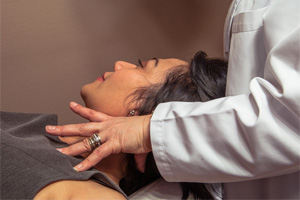Chiropractic Adjustments
An Adjustment is the name given to the most common treatment performed by the Chiropractor.
After locating the regions of fixation in the patient’s spine, the chiropractor will usually place his hands on the patient’s neck or back. He or she will make a low-force manual manoeuvre in the direction of the joint restoring proper motion.
Effects of the chiropractic adjustment include:
- Increased Joint Mobility
- Decreased Local Tenderness
- Decreased Muscle Tension
- Improved Muscle Co-ordination
These effects can be felt both at the point of treatment or related parts of the body. For example, research has shown that adjustments of the spine between the shoulders can reduce headache for patients with a particular condition.
Adjustments are most frequently performed on the joints of the patient’s spine or pelvis however adjustments to wrists, elbows, knees, ankles and hips can also be beneficial for some patients.
 When the treatment happens a click or pop frequently, but not always, occurs. This is a normal phenomena and is similar to the sensation of pulling your fingers. The technical term is called cavitation. This is the release of air bubbles inside the joint fluid as the distance between the bones rapidly increases. The loudness of this sound is usually co-incidental and not related to the outcome of the therapy.
When the treatment happens a click or pop frequently, but not always, occurs. This is a normal phenomena and is similar to the sensation of pulling your fingers. The technical term is called cavitation. This is the release of air bubbles inside the joint fluid as the distance between the bones rapidly increases. The loudness of this sound is usually co-incidental and not related to the outcome of the therapy.
For many patients this form of therapy is a pleasant experience. The first time, however, it can feel a bit strange or uncomfortable. It is also quite common to experience local tenderness and sometimes increased symptoms. If this happens then it usually calms down within a few hours, or the next day. If any post-treatment discomfort lasts for more than 48 hours please discuss this with your Chiropractor.
Your Chiropractors will do their best to explain the treatment and how you are likely to react. They will also give you tips on how to avoid irritation and exacerbation of your condition.
This treatment is one of the safest and most efficient manners of treating pain of musculoskeletal origin.
Below are some links for further information. As always, please feel free to ask your chiropractor if you have any questions that aren’t answered here.
Related Pages
Further Reading
Joint cracking and popping: Understanding noises that accompany articular release